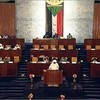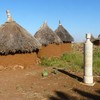Genetically modified cotton divides politicians and experts in Sudan
Genetically modified cotton took root in Sudan in 2012 amid an official fanfare. Following a successful trial in Shambat, the Minister of Agriculture and Forestry Abdulhalim Ismail Motaafi launched an initial area of 100,000 acres, which he says would be expanded around eightfold.
But local farmers are less enthusiastic, fearing for their financial futures while experts worry about the damage to public health.
My experience in cultivating genetically modified cotton contradicts the claims of the governmental authorities.”My experience in cultivating genetically modified cotton contradicts the claims of the governmental authorities that such crops would not require the use of pesticides since I need to spray my crop three times,” says Abdulaziz Abdullah, a Rahad project farmer.
He adds that, using the new seeds, he typically produced yields of between 1.55 to 5.1 quintals per acre, far lower than government promises of producing 14 quintals per acre.
Genetic Engineering Expert at Khartoum University Owab Nour warns genetic modification could create aggressive new plants which would affect cultivated crops, create weeds which are difficult to control and lead to the disappearance of local genotypes strains which are an important genetic resource.
Others fear that Sudan may experience a repeat performance of India’s difficult experience. In his research on 'Cultivating genetically modified crops: benefits and risks and the Sudanese experience in genetically modifying cotton’, Professor of Genetics and Plant Breeding Marouf Ibrahim Mohamed wrote that the cultivation of genetically modified cotton in India took place in 2002 amid hopes and promises of a broader welfare among farmers”.
But he described how initial optimism was quashed. Farmers faced huge debts due to the high production costs: One kilogram of seeds cost US$67 and one acre of land requires eight kilograms of seeds, pushing the bill to US$536 per acre, compared to regular seeds that do not exceed US$1 for an acre.
In addition, he wrote, more pesticides were needed to combat new, more resistant, weeds. Consequently, the local agricultural economy has completely crashed in few years with significant losses for small marginal farmers,” he wrote, adding that the Indian Committee of Agriculture in 2012 recommended an immediate halt on field experiments with genetically modified crops.
Many are asking why the Sudanese government is choosing to follow in the footsteps of India, which has now shunned the new technology as a failure.
But within Sudan, cotton is seen as a potential growth area in a dismal economic climate. Mohammed Hasan Jabara, Undersecretary of the Ministry of Agriculture, says: The experience of cultivating genetically modified cotton has renewed the position of cotton as a supporter for the Sudanese economy.”
He says the Sudanese government has initiated the project after conducting several studies on the Indian experience and no risks have been reported”.
Government agencies insist it is necessary to cultivate genetically modified cotton and import its seeds to sell them to farmers.
Cultivating genetically modified cotton breaches the law of bio-safety and compromise the consumer’s right.”But there are also concerns about health risks. In 2006, experts, doctors and social services workers in the state of Madhya Pradesh in India submitted a report detailing the effects of working on genetically modified cotton. People with direct contact with genetically modified cotton suffer allergies of various body parts including hands, feet, face, eyes and nose,” according to the report.
Mararouf Hussein, from the bio-safety committee, expresses fears about consumer rights. Cultivating genetically modified cotton breaches the law of bio-safety and compromise the consumer’s right. Therefore, it is required to investigate all laboratories and research centres to avoid negative health effects.”
In addition, Noha Sammani, Professor at the Faculty of Agriculture at Jazira University, Horticulture section says the seed of the genetically modified cotton plant was of no use for further production: The seed can not be used in oil as it contains harmful bacteria to humans. So overall, the experience of such cultivation in Sudan has failed on all levels.”




